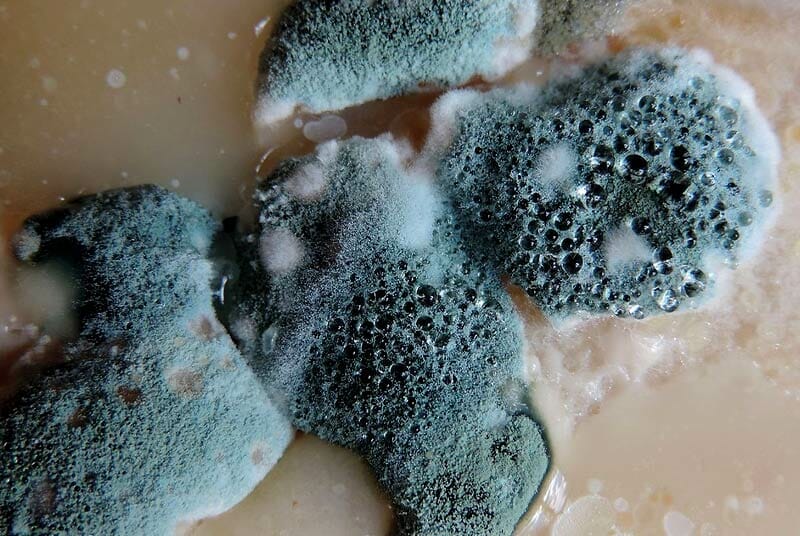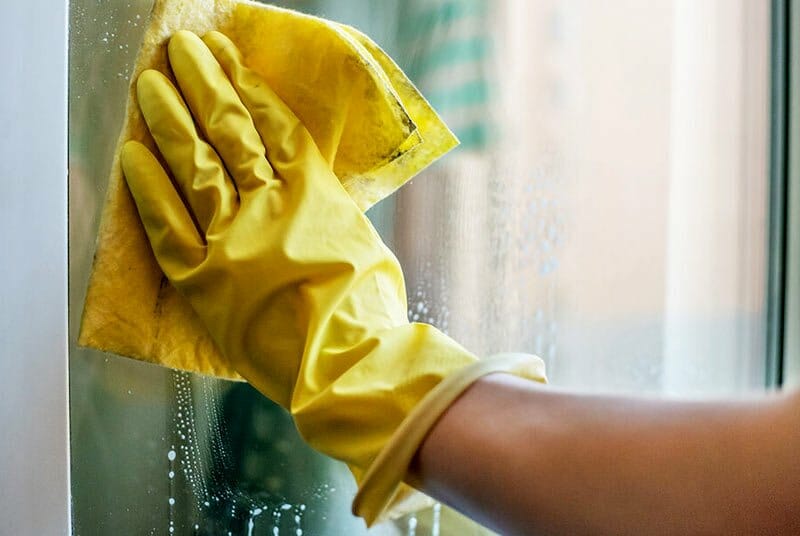Mold is a member of the fungus family and can thrive in both indoor and outdoor settings. Outside, mold plays a vital role in breaking down organic matter, but when found indoors, it can present health hazards and, at times, be harmful.
Some of the most common toxic molds are Fusarium, Penicillium, Aspergillus, Stachybotrys chartarum, Cryptococcus neoformans, and Histoplasma capsulatum, while Alternaria, Dresclera, Nigrospora, Pithomyces, Ulocladium, Aureobasidium, Stemphylium are some of the most prevalent non-toxic molds.
So, keep this article; it can help you learn about mold in detail.
What we cover
ToggleWhat is mold?
Mold is a fungus that often looks like vague spots of different colors. Various species have been identified that come under the mold. No doubt, the presence of the mold can pose a severe health risk to you and your family if they are present at home. But not every mold is toxic.
There are non-toxic molds, including Alternaria, nigrospora, dresclera, pithomyces, aureobasidium, stemphylium, and ulocladium. These types of mold do not produce mycotoxins, so they are not that hazardous to the health.
But it does not mean that you do not take it seriously if you find mold somewhere indoor or outdoor. Consulting experts and getting them removed help prevent you from any potential health hazards that can be caused due to mold.

Where can mold be found?
Mold can be found anywhere, indoors and outdoors. Shady, damp areas and places where leaves or other vegetation is decomposing are the most feasible place for mold. Along with this, it can be found in basements, kitchens, and bathrooms.
Drywall, ceiling tiles, rug, furniture, paneling, wallpaper, roofing, ductwork, and plumbing areas are where mold grows aggressively and are rare to notice.
Types of molds
While mold is found everywhere, you go and it is not always harmful. There are certain types of mold that can pose a severe health hazard risk to you and your family if they are present in your home or premises. Mold is defined in two categories:
- Toxic
- Non-toxic
If you live in a humid environment and you can see mold in your home or office, you need to get it treated. Though toxic molds cannot be seen with naked eyes, the mold you can see is non-toxic or can be treated easily.
Toxic mold mainly grows in dark and humid areas. The presence of toxic mold makes your indoor appearance ugly and unpleasant. It affects indoor air quality and directly affects your health.
No doubt, inhaling fresh air helps in physical and mental wellbeing. And that is why you should never ignore mold on your property. Though they are not poisonous, the chemical property or toxic mold produces mycotoxins (myco is a prefix that means fungal) that can lead to severe health issues.
Mycotoxins
Mycotoxins are chemical byproducts of metabolic processes. Metabolic processes contribute to maintaining life, such as converting food into energy or cellular respiration, as some specific mycotoxins can cause a harmful response in humans and animals, even in minor amounts. It can cause severe health issues like triggering allergies or asthma attacks.
Toxic molds, or toxigenic molds
Toxigenic mold is the combination of chemical metabolic byproducts called mycotoxins, which can lead to toxic reactions in the human and animal bodies. Mycotoxins are hazardous chemicals and can travel with mold cells.
There is numerous research that proves that toxigenic mold has the potential to travel through the air on every small particle of dust or small piece of wallpaper, which can easily be inhaled during the breath.
1. Aspergillus species
The Aspergillus species is the most prevalent species that can cause chronic pulmonary infections. It can affect health to the degree that it cannot be healed easily.
2. Cryptococcus neoformans
This sort of mold can be found worldwide. Individuals can get infected after inhaling their cells. It is very rare for the immune system, so it can be severe. The presence of this sort of mold spores in the human body can cause a later infection.
3. Histoplasma capsulatum
Histoplasma Capsulatum causes infectious diseases. Inhaling H. Capsulatum can cause a lung infection. It can also be life-threatening if acquired to an extent. This mold sors mostly found in soil and can be airborne from soil disturbances like digging, excavation, or building demolition.
The presence of a toxigenic mold species does not necessarily mean the presence of mycotoxins. Also, it is difficult to evaluate whether the mold is producing mycotoxins or not just by looking at it. Most commonly found toxigenic molds found growing indoors include:
- Fusarium species
- Penicillium species
- Stachybotrys chartarum
Non-toxic molds
Unlike toxic molds, there are also some non-toxic molds. Some of the most common non-toxic molds include alternaria, dresclera, nigrospora, pithomyces, ulocladium, aureobasidium, stemphylium etc. Let’s have a look at them.
1. Alternaria
Alternaria is a Deuteromycetes fungi genus. It’s one of the most widely distributed genera on the planet. Plant pathogenic Alternaria species are well-known. It can be found in a wide range of cultures, crops, and industrial products as a facultative pathogen.
2. Dresclera
Drechslera is a fungus genus. Plant pathogens make up a large portion of this genus. As a result, Drechslera can be discovered in soil and plant remnants. These species induce allergies in humans, which frequently result in allergic sinusitis. In men, they cause type I fungal hypersensitivity.
3. Nigrospora
Nigrospora is a fungus genus that belongs to the Trichosphaeriaceae family. The genus is found all over the world. As a leaf pathogen, it can be found in soil, air, and plants. It can grow as an endophyte, producing secondary metabolites that are antiviral and antifungal.
4. Pithomyces
Pithomyces chartarum is a fungus that is mostly found in tropical and subtropical countries, as well as other warmer regions. It feeds on the decaying leaves and stems of a variety of plants.
Species have been isolated from mammals exhibiting a variety of illness signs. It can be found all over the world, especially in the UK, Europe, and the Netherlands.
5. Ulocladium
Ulocladium is a fungus genus. Plant diseases and food spoilage agents can both be found in this genus. Enzymes that are biocontrol mechanisms are found in other species. Because mold requires water to thrive, some members of the genus can infiltrate homes and are a symptom of wetness.
6. Aureobasidium
Aureobasidium is a fungus genus that belongs to the Dothioraceae family. Pierre Viala and Gaston Boyer described the genus for the first time in 1891. It can be found growing inside on constantly moist surfaces, particularly in kitchens and toilets, on shower curtains, and in liquid waste products.
7. Stemphylium
Stemphylium herbarum is the anamorph (asexual version) of the fungi Pleospora herbarum, and it is a common mold in the Pleosporaceae family.
This mold is a known plant pathogen that can infect onions, tomatoes, durum wheat, lentils, and dates, among other species. It’s typically present in plant matter and soil all throughout the planet. Environmental spores are particles that cause allergic responses.
Prevent molds from spreading over your house
So, after knowing about the molds and their nature, it is really important to understand what you can do against mold in your home. The best way to prevent mold growth is to control moisture. Including practicing moisture control, you can take other actions, including:
- Evaluate and fix any source of water leakage on your property. Homeowners may require a plumber or an HVAC contractor to diagnose and fix the water leak. (Moisture is considered one of the most likely sources of feeling molds). Use appliances to control indoor humidity. Ideal indoor humidity must be around 40%.
- If you find mold in your home interior, clean them using soap and a sponge to remove them effectively.
- If moldy areas are dry, lightly spray a water mist on them. Practicing this will prevent you from sending mold cells into the air during cleaning.
- Use appliances for exceptional ventilation. Installing exhaust fans in the kitchen, dishwashing, or laundry area can help prevent mold development on your property.
If there is excessive damage to a building or home after a flood or plumbing failure, or you are cleaning the entire area, be sure to put all materials used in cleaning in a durable garbage bag and seal it. Mold has the property to travel in the air that can infect your health and lungs.

Protect yourself from mold cells/spores and mycotoxins or toxic-mold
Here are some ways to protect yourself from toxic molds:
- Use high-grade protection to cover your nose and mouth when handling moldy materials. An N95 particulate respirator is recommended.
- Wear clothing covering your arms and legs to avoid contact with mold cells. Also, discard the clothing after every cleaning or avoid wearing it before cleaning.
- Protect your eye, skin, nose, and mouth if you practice cleaning moldy areas.
- A high-performance mold air purifier can help clean the air, even as work progresses. Air purification can dramatically help in reducing airborne particulates, including mold, and reduce or prevent any musty odors.














